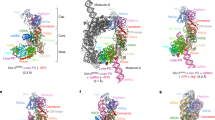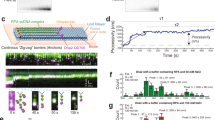Abstract
Many classes of small RNA (sRNA) involved in RNA silencing are generated by double-stranded RNA (dsRNA) processing. Although principles of sRNA biogenesis have emerged, newly identified classes of sRNAs have features that suggest additional biogenesis mechanisms. Tetrahymena thermophila expresses one such class, comprising sRNAs of 23 and 24 nucleotides (nt) with an absolute strand bias in accumulation. Here we demonstrate sRNA production by the T. thermophila Dicer Dcr2 and the RNA-dependent RNA polymerase Rdr1, which purifies as a multisubunit RNA-dependent RNA polymerase complex (RDRC). Dcr2 and RDRC interact, stimulating Dcr2 activity. Moreover, Dcr2 specificity is influenced by RDRC beyond this physical interaction, as Dcr2 generates discrete 23- and 24-nt sRNAs only from dsRNA with a 5′-triphosphate. These findings suggest that sRNA strand bias arises from Dcr2 processing polarity, conferred by physical and functional coupling of RDRC and Dicer enzymes.
This is a preview of subscription content, access via your institution
Access options
Subscribe to this journal
Receive 12 print issues and online access
$189.00 per year
only $15.75 per issue
Buy this article
- Purchase on Springer Link
- Instant access to full article PDF
Prices may be subject to local taxes which are calculated during checkout







Similar content being viewed by others
References
Zamore, P.D. & Haley, B. Ribo-gnome: the big world of small RNAs. Science 309, 1519–1524 (2005).
Parker, J.S. & Barford, D. Argonaute: a scaffold for the function of short regulatory RNAs. Trends Biochem. Sci. 31, 622–630 (2006).
Tomari, Y. & Zamore, P.D. Perspective: machines for RNAi. Genes Dev. 19, 517–529 (2005).
Gregory, R.I., Chendrimada, T.P., Cooch, N. & Shiekhattar, R. Human RISC couples microRNA biogenesis and posttranscriptional gene silencing. Cell 123, 631–640 (2005).
Maniataki, E. & Mourelatos, Z. A human, ATP-independent, RISC assembly machine fueled by pre-miRNA. Genes Dev. 19, 2979–2990 (2005).
Khvorova, A., Reynolds, A. & Jayasena, S.D. Functional siRNAs and miRNAs exhibit strand bias. Cell 115, 209–216 (2003).
Vazquez, F. et al. Endogenous trans-acting siRNAs regulate the accumulation of Arabidopsis mRNAs. Mol. Cell 16, 69–79 (2004).
Kim, V.N. Small RNAs just got bigger: Piwi-interacting RNAs (piRNAs) in mammalian testes. Genes Dev. 20, 1993–1997 (2006).
Lee, S.R. & Collins, K. Two classes of endogenous small RNAs in Tetrahymena thermophila. Genes Dev. 20, 28–33 (2006).
Vagin, V.V. et al. A distinct small RNA pathway silences selfish genetic elements in the germline. Science 313, 320–324 (2006).
Ambros, V., Lee, R.C., Lavanway, A., Williams, P.T. & Jewell, D. MicroRNAs and other tiny endogenous RNAs in C. elegans. Curr. Biol. 13, 807–818 (2003).
Ruby, J.G. et al. Large-scale sequencing reveals 21U-RNAs and additional microRNAs and endogenous siRNAs in C. elegans. Cell 127, 1193–1207 (2006).
Pak, J. & Fire, A. Distinct populations of primary and secondary effectors during RNAi in C. elegans. Science 315, 241–244 (2007).
Sijen, T., Steiner, F.A., Thijssen, K.L. & Plasterk, R.H. Secondary siRNAs result from unprimed RNA synthesis and form a distinct class. Science 315, 244–247 (2007).
Cerutti, H. & Casas-Mollano, J.A. On the origin and functions of RNA-mediated silencing: from protists to man. Curr. Genet. 50, 81–99 (2006).
Vaucheret, H. Post-transcriptional small RNA pathways in plants: mechanisms and regulations. Genes Dev. 20, 759–771 (2006).
Mochizuki, K. & Gorovsky, M.A.A. Dicer-like protein in Tetrahymena has distinct functions in genome rearrangement, chromosome segregation, and meiotic prophase. Genes Dev. 19, 77–89 (2005).
Malone, C.D., Anderson, A.M., Motl, J.A., Rexer, C.H. & Chalker, D.L. Germ line transcripts are processed by a Dicer-like protein that is essential for developmentally programmed genome rearrangements of Tetrahymena thermophila. Mol. Cell. Biol. 25, 9151–9164 (2005).
Mochizuki, K. & Gorovsky, M.A. Small RNAs in genome rearrangement in Tetrahymena. Curr. Opin. Genet. Dev. 14, 181–187 (2004).
Yao, M.C. & Chao, J.L. RNA-guided DNA deletion in Tetrahymena: an RNAi-based mechanism for programmed genome rearrangements. Annu. Rev. Genet. 39, 537–559 (2005).
Howard-Till, R.A. & Yao, M.C. Induction of gene silencing by hairpin RNA expression in Tetrahymena thermophila reveals a second small RNA pathway. Mol. Cell. Biol. 26, 8731–8742 (2006).
Motamedi, M.R. et al. Two RNAi complexes, RITS and RDRC, physically interact and localize to noncoding centromeric RNAs. Cell 119, 789–802 (2004).
Tang, G., Reinhart, B.J., Bartel, D.P. & Zamore, P.D. A biochemical framework for RNA silencing in plants. Genes Dev. 17, 49–63 (2003).
Zhang, H., Kolb, F.A., Brondani, V., Billy, E. & Filipowicz, W. Human Dicer preferentially cleaves dsRNAs at their termini without a requirement for ATP. EMBO J. 21, 5875–5885 (2002).
Macrae, I.J. & Doudna, J.A. Ribonuclease revisited: structural insights into ribonuclease III family enzymes. Curr. Opin. Struct. Biol. 17, 138–145 (2006).
Kurihara, Y. & Watanabe, Y. Arabidopsis micro-RNA biogenesis through Dicer-like 1 protein functions. Proc. Natl. Acad. Sci. USA 101, 12753–12758 (2004).
Dlakic, M. DUF283 domain of Dicer proteins has a double-stranded RNA-binding fold. Bioinformatics 22, 2711–2714 (2006).
Makeyev, E.V. & Bamford, D.H. Cellular RNA-dependent RNA polymerase involved in posttranscriptional gene silencing has two distinct activity modes. Mol. Cell 10, 1417–1427 (2002).
Rossi, J.J. Mammalian Dicer finds a partner. EMBO Rep. 6, 927–929 (2005).
Leuschner, P.J., Obernosterer, G. & Martinez, J. MicroRNAs: Loquacious speaks out. Curr. Biol. 15, R603–R605 (2005).
Kurihara, Y., Takashi, Y. & Watanabe, Y. The interaction between DCL1 and HYL1 is important for efficient and precise processing of pri-miRNA in plant microRNA biogenesis. RNA 12, 206–212 (2006).
Tomari, Y., Matranga, C., Haley, B., Martinez, N. & Zamore, P.D. A protein sensor for siRNA asymmetry. Science 306, 1377–1380 (2004).
Rose, S.D. et al. Functional polarity is introduced by Dicer processing of short substrate RNAs. Nucleic Acids Res. 33, 4140–4156 (2005).
Preall, J.B., He, Z., Gorra, J.M. & Sontheimer, E.J. Short interfering RNA strand selection is independent of dsRNA processing polarity during RNAi in Drosophila. Curr. Biol. 16, 530–535 (2006).
Pontes, O. et al. The Arabidopsis chromatin-modifying nuclear siRNA pathway involves a nucleolar RNA processing center. Cell 126, 79–92 (2006).
Lee, R.C., Hammell, C.M. & Ambros, V. Interacting endogenous and exogenous RNAi pathways in Caenorhabditis elegans. RNA 12, 589–597 (2006).
Duchaine, T.F. et al. Functional proteomics reveals the biochemical niche of C. elegans DCR-1 in multiple small-RNA-mediated pathways. Cell 124, 343–354 (2006).
Gazzani, S., Lawrenson, T., Woodward, C., Headon, D. & Sablowski, R. A link between mRNA turnover and RNA interference in Arabidopsis. Science 306, 1046–1048 (2004).
Axtell, M.J., Jan, C., Rajagopalan, R. & Bartel, D.P. A two-hit trigger for siRNA biogenesis in plants. Cell 127, 565–577 (2006).
Allen, E., Xie, Z., Gustafson, A.M. & Carrington, J.C. microRNA-directed phasing during trans-acting siRNA biogenesis in plants. Cell 121, 207–221 (2005).
Yoshikawa, M., Peragine, A., Park, M.Y. & Poethig, R.S. A pathway for the biogenesis of trans-acting siRNAs in Arabidopsis. Genes Dev. 19, 2164–2175 (2005).
Schramke, V. et al. RNA-interference-directed chromatin modification coupled to RNA polymerase II transcription. Nature 435, 1275–1279 (2005).
Jensen, T.H. & Moore, C. Reviving the exosome. Cell 121, 660–662 (2005).
Witkin, K.L., Prathapam, R. & Collins, K. Positive and negative regulation of Tetrahymena telomerase holoenzyme. Mol. Cell. Biol. 27, 2074–2083 (2007).
Vermeulen, A. et al. The contributions of dsRNA structure to Dicer specificity and efficiency. RNA 11, 674–682 (2005).
Acknowledgements
We thank the Collins laboratory for discussions and comments on this manuscript, and I. Macrae and J. Doudna for technical suggestions. This research was supported by a Howard Hughes Medical Institute Predoctoral Fellowship to S.R.L.
Author information
Authors and Affiliations
Contributions
S.R.L. performed the experiments, and K.C. and S.R.L. wrote the manuscript.
Corresponding author
Ethics declarations
Competing interests
The authors declare no competing financial interests.
Supplementary information
Supplementary Fig. 1
The RDRC and Dcr2 generate characteristic products on different templates. (PDF 8775 kb)
Supplementary Fig. 2
RDRC products can be diced by Dcr2 after double-stranded RNA synthesis. (PDF 1473 kb)
Supplementary Fig. 3
Intact RDRC stimulates dicing by Dcr2. (PDF 3249 kb)
Supplementary Table 1
Summary of mass spectrometry analysis. (PDF 2772 kb)
Rights and permissions
About this article
Cite this article
Lee, S., Collins, K. Physical and functional coupling of RNA-dependent RNA polymerase and Dicer in the biogenesis of endogenous siRNAs. Nat Struct Mol Biol 14, 604–610 (2007). https://doi.org/10.1038/nsmb1262
Received:
Accepted:
Published:
Issue Date:
DOI: https://doi.org/10.1038/nsmb1262
This article is cited by
-
Identification of oligo-adenylated small RNAs in the parasite Entamoeba and a potential role for small RNA control
BMC Genomics (2020)
-
Tudor domain ERI-5 tethers an RNA-dependent RNA polymerase to DCR-1 to potentiate endo-RNAi
Nature Structural & Molecular Biology (2012)
-
The molecular architecture of human Dicer
Nature Structural & Molecular Biology (2012)
-
Establishment of a Cre/loxP recombination system for N-terminal epitope tagging of genes in Tetrahymena
BMC Microbiology (2010)
-
Small RNAs in transcriptional gene silencing and genome defence
Nature (2009)



